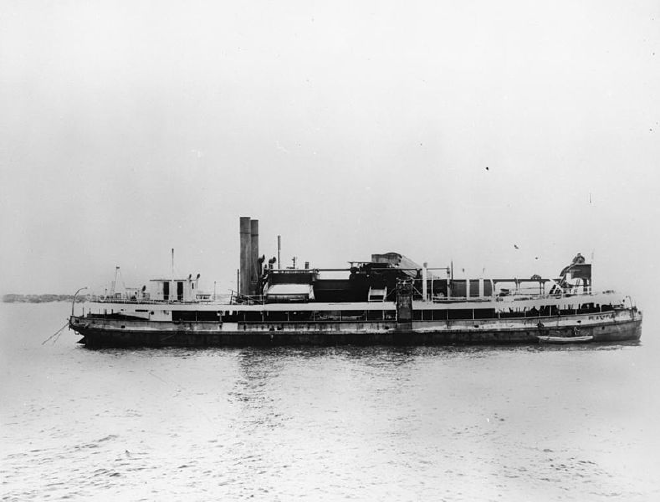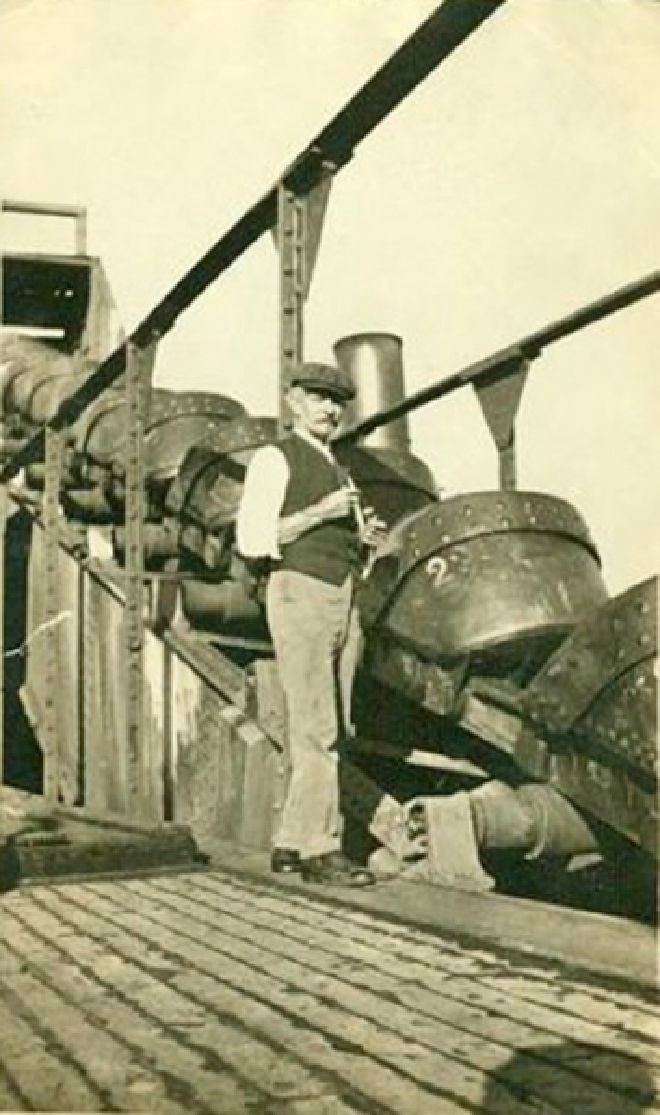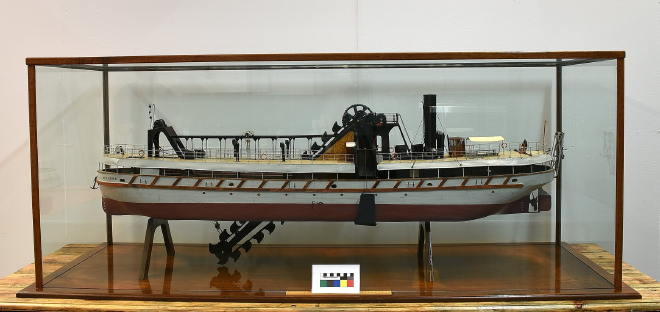Platypus (1926)
Table of Contents
1 - Summary #
The dredge vessel ‘Platypus’ was constructed in 1883 by Messrs. Simons and Co. of Glasgow on behalf of the Queensland Government, and it made its way to Brisbane by the middle of 1884. It operated along the Queensland coast and played an instrumental role in establishing the port of Cairns. The ship also contributed to key developmental projects in Townsville and carved out channels at various locations including Normanton, Port Douglas, Thursday Island, Cooktown, and Brisbane.
The ‘Platypus’ was retired from service in December 1923, and by 1926 it was stripped of all valuable equipment at a dry dock in South Brisbane. In October 1926, after 42 years spent dredging harbours and tidal rivers across Queensland, the ‘Platypus’ was intentionally sunk at the south-eastern point of Peel Island to create a breakwater at the lazaret. Its purpose was to shield passenger and motor boats docking at the jetty from strong south-easterly winds. The ship’s successor, the ‘Platypus II’, was already under construction when its ‘Platypus’ met its end.
2 - Timeline #
The below timeline contains notable dates found in records online. As more information is found this table will be updated.
| Year | Event |
|---|---|
| 1883 | Built by Messrs. William Simons and Co. in Renfrew, Glasgow, Scotland1,2 at London Works Yard, Yard No. 2353. She was built for the Queensland Government at a cost of £33,5504. |
| 1884 | June 27th - Arrived off Cape Moreton, Brisbane at 9.45 a.m5. June 28th - First mention in the Brisbane newspapers, expecting it to arrive in Brisbane port that morning. Also contains an extract from the Engineering report from shipbuilders, Messrs. William Simons and Co5. November - Began dredging in Townsville6. |
| 1889 | Was joined in Townsville by another bucket-ladder dredge, the ‘Octopus’6. |
| 1897 | December - Captain Evans appointed to take charge of the dredge7. |
| 1905 | Legislative Assembly Hansard7. “Mr Woods” (assumed to be Michael Joyce Reginald Woods8, Member of the Queensland Legislative Assembly, 1902–1909) asked questions to the Treasurer regarding the Platypus and Captain Evans. |
| 1908 | Crash with Tinana, sustained little damage9. |
| 1923 | December - Decommissioned9. |
| 1926 | October 21st - Stripped of gear and scuttled at Peel Island to make a breakwater at the lazaret4,2. |
| 1932 | British registry closed.3 |
3 - Platypus engineering #
The Platypus, a Dredge Bucket iron screw steamer, was launched on the 17th of November, 1883. The vessel was assigned the official number ‘87316’. The esteemed shipbuilding firm William Simons & Co. Ltd., based out of Renfrew, Glasgow, Scotland at the London Works Yard (Yard No. 235)3, was responsible for its construction. The Platypus boasted substantial dimensions; it had a tonnage of 818 gross register tons (grt) / 399 net register tons (nrt), a length of 189 feet, a breadth of 38.7 feet and a depth of 14.2 feet3. Equipped with a two-screw steam engine, it was designed to perform efficiently and reliably in various marine dredging operations. This vessel was first registered in Brisbane on the 26th of July, 18843.

The Brisbane Courier, Sat 28 Jun 18845, wrote ‘The Engineering of the 25th January thus refers to this vessel:’
The twin screw hopper dredger Platypus, recently launched by Messrs W Simon and Co., Renfrew, steamed down the river on Saturday last, and moored opposite Garvel Dock, Greenock. After filling her hopper with nearly 1000 tons of dredgings, at the rate of 500 tons per hour, the vessel lifted its bucket-girder and steamed to Lochlong, where her load was instantly deposited. A speed of ten miles per hour was obtained.5
The Platypus has an awning deck, and has been constructed for the Queensland Government for the purpose of deepening the rivers and bars at the Northern ports of Queensland, and is intended to steam considerable distances along that coast. This is the eighteenth hopper dredger this firm has designed and constructed, and is in all respects one of the most complete and powerful dredgers afloat.5
She is fitted with the builders' traversing bucket ladder, in order to cut her own flotation through shoals and banks. The buckets, wheels, and frictions are all of steel. There are powerful triple independent steam crabs fore and aft, hydraulic ladder hoist gear, a complete workshop for repairs, consisting of turning lathes, drilling machines, and planing machine, and two smiths' hearths with Root’s blowers, all driven by steam power. The machinery for propelling the vessel consists of two independent sets of compound surface-condensing 500-horse power. The boilers are made entirely of steel, and are of such dimensions that the working pressure of and apertures closed up, the vessel was masted and loaded with coal, and proceeded under steam to Brisbane, via the Suez Canal.5

4 - Townsville, Cairns, and Cooktown #
In November 1884, a project was launched to transform the Port of Townsville6. A dredging operation was initiated with the aim of accommodating larger ships within the port’s confines. This marked a significant milestone in Townsville’s maritime history. Fast forward to the present day, and the Townsville shipping channel has evolved into an impressive 14.9km stretch10. The extensive channel is divided into three distinct sections; namely, the Sea Channel and two sub-sections known as the Outer and Inner Platypus Channels10.

The Platypus played an instrumental role in these early days of expansion. Unlike any ordinary dredge, the Platypus was a bucket-ladder dredge fitted with a series of buckets on an endless loop6. Traditionally, loaded buckets would ascend to the top of this ladder before releasing their contents down a chute onto a barge for transport. However, Platypus shattered this norm with its modern steel design that allowed it to both dredge and convey materials within her bow6. The year 1889 welcomed another addition to this industrious fleet - ‘Octopus’6. Much like its predecessor Platypus, Octopus was also a bucket-ladder dredge, further contributing to Townsville’s maritime progress and expansion. A model of the Octopus is on display at the Maritime Museum of Townsville6.

5 - Legislative Assembly Hansard 1905 #
I found this next section to be simply interesting. The following was taken Qld Parliament Documents, Parliamentary Debates, Legislative Assembly Hansard 1905, Page 178 (PDF page 2 of 2)7.
Parliamentary Debates
(Hansard)
Legislative Assembly
THURSDAY, 19 JANUARY 1905
THE CAPTAIN OF THE DREDGE “PLATYPUS.” Mr. WOODS asked the Treasurer-
- When was Captain Evans appointed to take charge of the dredge “Platypus”?
- What are his qualifications for occupying the position of dredgemaster?
- Upon whose recommendation was he appointed?
- Did he ever have any previous experience of a dredging plant?
- Is it true that Captain King was sent specially from Brisbane to Karumba, Norman Bar, to take charge of the dredge “Platypus” and plant as navigating master, and to navigate same from Norman Bar to Thursday Island and from there to Port Douglas?
- If Captain Evans is competent, why was it necessary to send another captain to the Norman Bar to navigate the “Platypus;” and if incompetent, why is he retained?
- Is the Minister aware that on the voyage of this dredge to the Norman Bar when Captain Evans was navigating the plant he ran it on a chartered reef near the Clermont Lightship in broad daylight?
- Does this occurrence appear in the ship’s log?
- Does the Minister consider it necessary to retain the services of a navigating master on any of the dredging plants in the present financial position of the State?
- Is the Minister aware that in New South Wales the chief engineer is master of the plant?
- Is the Minister aware that there has been considerable friction between Captain Evans and the dredge employees, and that liquor was sold on the launch to the employees with the full knowledge of the dredgemaster?
- What explanation did Captain Evans make in connection with the drowning of one of the dredge hands in the Norman River during the Easter holidays last year?
The TREASURER (Hon, W. Kidston, Rockhampton) replied-
- December, 1897.
- He is a master mariner, and works his dredge satisfactorily.
- The late Captain Almond recommended his appointment.
- Not known.
- Yes; to act as pilot through the Inner Route.
- Practically all vessels take a pilot through the Inner Route, and, as the plant was not insured, the department considered the course adopted advisable.
- Yes.
- Yes.
- All dredges must have an officer in charge, and it is considered that under the conditions obtaining here a nautical man is preferable. Sea-going dredges must have a navigating master.
- Details of the New South Wales dredge service are not available.
- The only disputes known were in connection with overtime; these were settled. Nothing is known as to the purchase of liquor by the employees.
- The occurrence was duly entered in the log-book. As a magisterial inquiry was held at Normanton the department did not take further action. Captain Evans was on board the dredge at the time.
6 - Wreck #
As the winter of 1923 rolled in, the ‘Platypus’ gracefully bowed out of service. This grand workhorse of a ship, having spent a respectable 42 years dredging harbours and tidal rivers across Queensland, was deservedly retired and given a final salute. The once powerful vessel was escorted to a dry dock in South Brisbane, where it was carefully disassembled. By 1926, it had been completely stripped of all its valuable equipment, leaving behind only an empty shell that bore testament to its industrious past.
Then came October 1926, when the ‘Platypus’ embarked on its final voyage. It wasn’t headed for another harbour or river but instead for Peel Island’s southeastern point. Under the bright autumn sky, the mighty ship was intentionally sunk.
This wasn’t an act of abandonment or disdain but rather one of strategic reassignment. The ‘Platypus’, having served as a protector of Queensland’s waterways for over four decades, now began its second life as a breakwater at the lazaret. There it would stand guard over passenger and motor boats docking at the jetty from the fierce south-easterly winds that frequently disturbed the tranquillity of Peel Island.
Even as this magnificent ship met its end beneath the waves, hope sprung anew in the form of its successor - ‘The Platypus II’. The construction was already underway when ‘The Platypus’ took her last breath. The legacy was set to continue; one era ended and another began.
-
The following is taken from the Australasian Underwater Cultural Heritage Database. ↩︎
-
Specific information about the ship builder from www.clydeships.co.uk/ ↩︎
-
The Brisbane Courier | Fri 22 Oct 1926 | Page 6 | “Old Dredge Sunk” ↩︎
-
The Brisbane Courier | Sat 28 Jun 1884 | Page 5 | “The New Dredge Platypus” ↩︎
-
Maritime Museum of Townsville’s post on the Platypus and Octopus ↩︎
-
Parliamentary Debates, Legislative Assembly | Thu 19 Jan 1905 | Qld Parliament Documents ↩︎
-
Wiki page on Michael Joyce Reginald Woods ↩︎
-
Stone, P. 2006. Encyclopedia of Australian Shipwrecks and other Maritime Incidents. Yarram, Victoria: Ocean Enterprises. ↩︎
-
Port of Townsville’s 2016 plans to upgrade the channels. Channel Upgrade FAQ’s ↩︎
